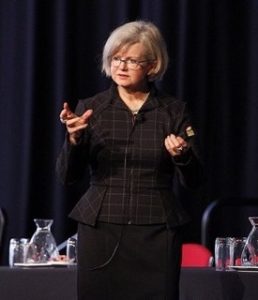Dr Fiona Kerr believes we still have a lot to learn about how incredible humans are.

The founder and Chief Executive of the NeuroTech Institute, Kerr has worked as an anthropologist, a psychologist, a mediator, a cognitive scientist and an engineer. She says we’re all “electrochemical bags of sensors” built to connect.
“When we’re face-to-face, we have a number of things [that happen] because we are in direct proximity,” Kerr says.
Eye contact gets our neurons firing, making parts of the brain “stand up”.
“We also have thousands of chemicals that we are swapping, that change the way that our brains work,” Kerr says. “We have interpersonal neural synchronisation.”
Kerr has worked with artists, technologists, economists, soldiers and nurses, and in organisations ranging from the Department of Defence to Cirque du Soleil.
We are all human
What they all have in common, Kerr says, is a need for complex problem solving and decisions.
She says cross-collaboration and brain synchronisation leads to better decision-making, something she was able to demonstrate in a 2021 study.
“In the control group, a person tackled a complex problem over a technological interface, and in the trial group strangers collaborated face-to-face,” Kerr says.
“One of them then tackled the complex problem via the technology. Each participant who had collaborated in-person learned faster, applied the knowledge longer, and scored better. We really can make each other smarter through that extra physiological and neurobiological activity that occurs when we are with each other.”
Kerr has also studied how leaders change our brains — for better or for worse. She says leaders of adaptive organisations tend to be complex thinkers who understand the importance of a strong vision and clear values.
“Without that, people won’t step into unknown environments,” she says.
[embedyt] https://www.youtube.com/watch?v=019Z0dAzNsQ[/embedyt]
Beware the shiny bauble
Kerr believes engineers have a responsibility to think carefully about what they’re trying to achieve, and actively push back against technological optimism.
“What I’d love is for engineers to think more widely about the problems they can solve, and about the questions they can ask,” she says. She wants engineers to be proactive enough to shape what the country does with technology and where it’s going.
Don’t start with the “shiny bauble” that’s being sold to you, she says. Instead, engineers should think about what they’re actually trying to achieve. The development of robot nurses, for instance, can overlook the uniqueness of non-technical interactions. “A human nurse can completely change a patient’s physiology in three to five minutes,” said Kerr.
“Something as simple as looking into a patient’s eyes and patting their hand can have a huge impact. It lowers your cortisol, lowers your adrenaline.”
“It also changes the way your hippocampus is firing; it starts your cortisol receptors taking cortisol out of your bloodstream. And the nice thing is it’s cyclic.”
Kerr continues, “When we ask a good question, then as engineers, we make brilliant technology. When we just allow profit to steer us towards things like sticky screens … technology is just as good at that, but we don’t build a better world.”
